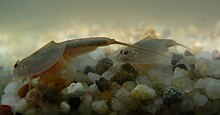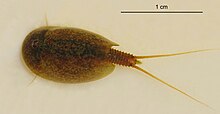Triopsidae
| Notostraca Temporal range: Carboniferous–Recent |
|
|---|---|
 |
|
| Triops australiensis | |
 |
|
| Lepidurus apus | |
| Scientific classification | |
| Kingdom: | Animalia |
| Phylum: | Arthropoda |
| Subphylum: | Crustacea |
| Class: | Branchiopoda |
| Subclass: | Phyllopoda |
| Order: |
Notostraca G. O. Sars, 1867 |
| Family: |
Triopsidae Keilhack, 1909 |
| Genera | |
The order Notostraca comprises the single family Triopsidae, containing the tadpole shrimp or shield shrimp. The two genera, Triops and Lepidurus, are considered living fossils, having not changed significantly in outward form since the Triassic. They have a broad, flat carapace, which conceals the head and bears a single pair of compound eyes. The abdomen is long, appears to be segmented and bears numerous pairs of flattened legs. The telson is flanked by a pair of long, thin caudal rami. Phenotypic plasticity within taxa makes species-level identification difficult, and is further compounded by variation in the mode of reproduction. Notostracans are omnivores living on the bottom of temporary pools and shallow lakes.
Notostracans are 2–10 centimetres (0.8–3.9 in) long, with a broad carapace at the front end, and a long, slender abdomen. This gives them a similar overall shape to a tadpole, from which the common name tadpole shrimp derives. The carapace is dorso-ventrally flattened, smooth, and bears no rostrum; it includes the head, and the two sessile compound eyes are located together on top of the head. The two pairs of antennae are much reduced, with the second pair sometimes missing altogether. The mouthparts comprise a pair of uniramous mandibles and no maxillipeds.
The trunk comprises a large number of "body rings", which appear to be body segments, but do not always reflect the underlying segmentation. The first eleven body rings compose the thorax and bear one pair of legs each, the last of which also bears the genital opening. In the female, it is modified to form a "brood pouch". The first one or two pairs of legs differ from the remainder, and probably function as sensory organs.
...
Wikipedia
